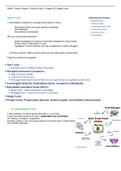Samenvatting
Investment and Portfolio Theory 2 Full Course Summary
- Instelling
- Universiteit Van Amsterdam (UvA)
- Boek
- Investments
This summary spans the chapters 4, 20 - 26 as well as Carhart (1997). Many colorful graphs and equations to illustrate the theories better with emphasis on real world examples. Main topics span Asset valuation, Derivatives and Portfolio Management
[Meer zien]






